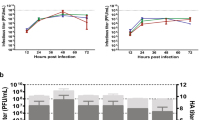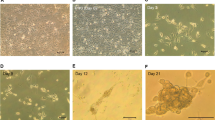Abstract
INFLUENZA virus was adapted to growth at 25° C by gradually lowering the temperature at which infected cells were incubated during serial passage until the optimum yield of infectious virus was obtained1. Using this method it was possible to adapt various strains of type A and B influenza viruses to growth at 25° C in tissue culture or embryonic eggs. Adaptation of the virus to reproduce at 25° C has resulted in its attenuation when tested in a susceptible host1. Infection of the host occurred without apparent disease but with good antibody response (my own unpublished results). During earlier work, purification of these variants was achieved using the limiting dilution technique, which is adequate but not highly reliable. The purpose of the study reported here was to develop plaque assay, and to select plaque progeny for more vigorous growth at 25° C. The development of plaques at 25° C was used also for clone purification of cold variants for genetic studies. Kidneys were excised from 1–6 day old chicks and were processed according to the method published earlier2 and incubated at 36° C. Monolayers of chick kidney cells were formed between the fourth and fifth day after seeding, and the cultures were infected immediately thereafter and transferred to incubation at 25° C. Briefly, the cell monolayer was washed with prewarmed Hanks balanced salt solution (BSS) and infected with the appropriate dilutions of the virus contained in a small volume; for example, when using 3 oz. prescription bottles, 0.5 ml. of a given dilution was inoculated. The adsorption was allowed to proceed for 1 h at room temperature with gentle mechanical agitation. The infected chick cell monolayers were then overlayered with agar; the composition of the agar overlay used was exactly like the one devised by Sugiura and Kilbourne3 for the Chang conjunctival cell line clone l-5c-4 but with a final agar concentration of 1.2 per cent instead of 0.9 per cent. After incubation for 5 days at 25° C a second overlay of the agar medium with neutral red was added. The cultures were returned to 25° C for further incubation.
This is a preview of subscription content, access via your institution
Access options
Subscribe to this journal
Receive 51 print issues and online access
$199.00 per year
only $3.90 per issue
Buy this article
- Purchase on Springer Link
- Instant access to full article PDF
Prices may be subject to local taxes which are calculated during checkout
Similar content being viewed by others
References
Maassab, H. F., Nature, 213, 612 (1967).
Maassab, H. F., Proc. US Nat. Acad. Sci., 45, 1035 (1959).
Sugiura, A., and Kilbourne, E. D., Virology, 26, 478 (1965).
Author information
Authors and Affiliations
Rights and permissions
About this article
Cite this article
MAASSAB, H. Plaque Formation of Influenza Virus at 25° C. Nature 219, 645–646 (1968). https://doi.org/10.1038/219645a0
Received:
Issue Date:
DOI: https://doi.org/10.1038/219645a0
Comments
By submitting a comment you agree to abide by our Terms and Community Guidelines. If you find something abusive or that does not comply with our terms or guidelines please flag it as inappropriate.



